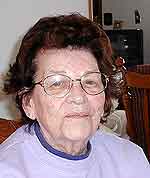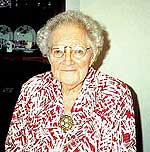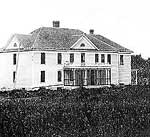By Dan Gunderson
Minnesota Public Radio
July 29, 2002
The poorhouse is a mostly forgotten part of American history. But a few people still remember - especially those who worked in the poorhouses.
| |
|
|
|
||
Times were tough when Irene Johnson went to work at the Lac Qui Parle County poorfarm in the 1930s. She was 16 years old. She didn't think she'd last a week, but ended up staying for 18 years. Irene says the work was hard, the hours were long. She was paid $25 a month to care for those with nowhere else to go. She can't remember anyone being turned away from the poorhouse.
"We had one come from Marietta. He had a beard down to here. It was all full of bugs and worms. We got him in the bathtub, I don't know if he knew what a bath was," says Johnson. "Yep, we had all kinds."
Now nearly 90 years old, Irene is surprised anyone wants to hear her poorfarm stories. She says most people seemed to like life on the poorfarm - they had a clean bed and plenty of good food. But it still bothers Irene that most residents were lonely and sad.
"The people didn't come to see them very often. They seemed to put them out there and forget them. And that was the tough part of it," Johnson says. "These people were your own so you couldn't help worrying about them either. You had to help them the best you could. we tried."
The Lac Qui Parle poorfarm opened in 1889. Over the years, many of its residents were mentally ill, disabled or alcoholics. Poorfarm workers had no special training, just common sense and compassion.
When Florence Haukos took over the Lac Qui Parle poorfarm in the 1950s, she did much more than cook and clean.
|
"The people didn't come to see them very often. They seemed to put them out there and forget them. And that was the tough part of it. These people were your own, so you couldn't help worrying about them."
- Irene Johnson, who worked at a poorfarm in the 1930s |
"I went out there. I didn't have high school education or nothing. Mrs. Cox that was there before me, she had the medicine in the pantry on a shelf. I didn't know what these medicines were for, so I'd go the the drugstore and take a bottle in there. I'd say, 'Bill, what's this for?' And he'd say, 'That's for an epileptic, don't ever forget to give it to him and you'll be OK.' And that's how I learned all this here," Haukos recalls.
There was no staff psychologist or nurse, just Florence and her seven children. Residents were sometimes violent. She recalls being threatened by a young man.
"'Florence,' he says, 'it's your fault I'm here. I'm going to beat you up so that you'll have to send me back.' And you didn't dare show you were scared," Haukos says. "I says, 'Jerry, you beat me up I'll call the sheriff. He'll come out here and you'll be in jail. If you don't like it get your damn stuff and take it out to the mailbox. And you look one way and the other and where the heck are you going to go?'"
Florence Haukos says she had to be tough. But she became very attached to some residents. Her eyes fill with tears as she talks about Gordy, a mentally retarded boy who had been abandoned.
| |
|
|
|
||
"One Saturday he made me so darn mad. He kept after me, he wanted to go to town. I said, 'Gordy, what the hell do you want in town?' 'I got things to do and I want to go to church. I gotta go to town,' he says. I said, 'I'll get supper ready and we'll go, but we're coming right home again.' He went into the dime store and bought a box of candy and had it wrapped and said, 'Here ma, this is for Mother's Day.' I coulda cried. It was things like that kinda got you down," Haukos recalls.
Many poorfarm workers were pragmatic. Florence Haukos says she made a deal with alcoholics - stay out of trouble and she'd let them have a beer on Saturday.
Poorfarm residents got a few dollars a month to spend as they chose. Erling Berntson worked at the poorfarm in Duluth. He says cash was quickly squandered by many residents.
p> "So then they'd go down and get boozed up. You know, that's what they lived for - have a snort. In fact, in later years when it changed to a nursing home, every Thursday we had a beer party for the residents. They could have one or two beers. And why not? They'd had it all their lives. Why take it away from them? Didn't hurt anything," Berntson says.Poorfarm residents often wandered into a nearby town and found the local bar. Linda Weiland remembers having to roust residents from the bar and drive them back to the farm. Weiland moved to the poorfarm in New Ulm in 1938, when her father became caretaker. When Linda Weiland married, she and her husband Norm took over the poorfarm and ran it until it closed in 1965.
| |
|
|
|
||
Most residents were single men.
"When my parents ran it, we had three ladies come. We had no place to put them except in the men's dining room. Of course, you put three ladies in with 20 men and they're going to sit and gawk at these ladies," Weiland remembers. "And the ladies just weren't happy that way, so my dad made a frame and we covered it with cloth, so they had a little privacy - although a lot of the gentlemen would come and peek over the screen."
Linda Weiland says the job required a lot of hard work, and a healthy dose of patience. Many residents suffered various forms of mental illness, but received little or no treatment.
"One man, he would take a tin can and sit by the river bank. There was a huge rock, and he would dip water on one side of the rock and pour it back in the river on the other side. He did that constantly. Sort of a therapy, I guess," says Weiland.
When the poorfarm in New Ulm closed, Norman and Linda Wieland lived just down the road. Linda says former residents returned often in hopes the poorfarm would reopen.
"After we closed the poorfarm, on Sundays they would drive up and sit on the bench outside. And of course, when we seen the car was there, Norm and I would walk up the road. And one of them made the remark, 'Well, here comes the boss and the cook. Now we can open the place up again,'" Weiland says.
There's little to mark the passing of the poorfarm era in America. Just the fading memories of the last generation to experience the poorhouse.



